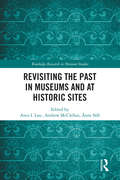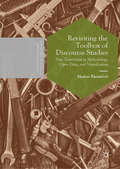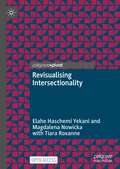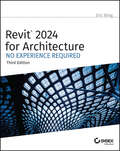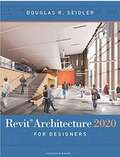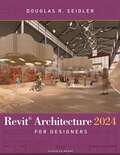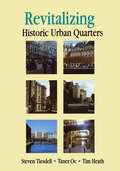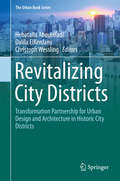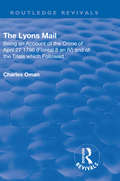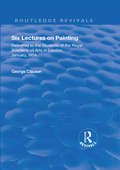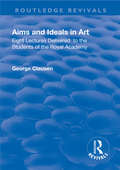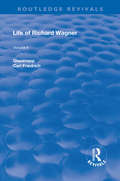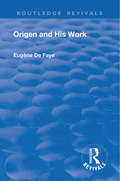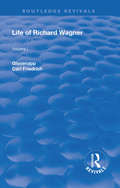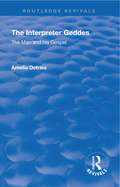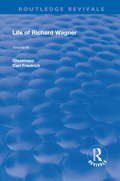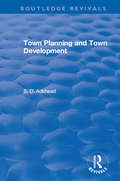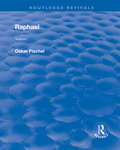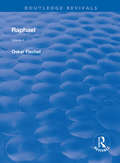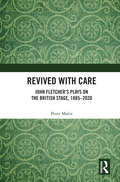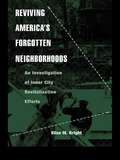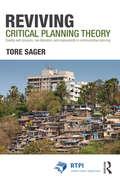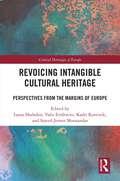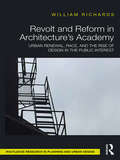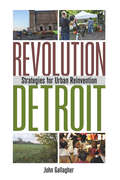- Table View
- List View
Revisiting the Past in Museums and at Historic Sites (Routledge Research in Museum Studies)
by Anca I. Lasc Andrew McClellan Änne SöllRevisiting the Past in Museums and at Historic Sites demonstrates that museums and historic spaces are increasingly becoming "backdrops" for all sorts of appropriations and interventions that throw new light upon the objects they comprise and the pasts they reference. Rooted in new scholarship that expands established notions of art installations, museums, period rooms, and historic sites, the book brings together contributions from scholars from intersecting disciplines. Arguing that we are witnessing a paradigm shift concerning the place of historic spaces and museums in the contemporary imaginary, the volume shows that such institutions are merging traditional scholarly activities tied to historical representation and inquiry with novel modes of display and interpretation, drawing them closer to the world of entertainment and interactive consumption. Case studies analyze how a range of interventions impact historic spaces and conceptions of the past they generate. The book concludes that museums and historic sites are reinventing themselves in order to remain meaningful and to play a role in societies aspiring to be more inclusive and open to historical and cultural debate. Revisiting the Past in Museums and at Historic Sites will be of interest to students and faculty who are engaged in the study of museums, art history, architectural and design history, social and cultural history, interior design, visual culture, and material culture.
Revisiting the Toolbox of Discourse Studies: New Trajectories in Methodology, Open Data, and Visualization (Postdisciplinary Studies in Discourse)
by Markus RheindorfThis book revisits discourse analytic practice, analyzing the idea that the field has access to, provides, or even constitutes a ‘toolbox’ of methods. The precise characteristics of this toolbox have remained largely un-theorized, and the author discusses the different sets of tools and their combinations, particularly those that cut across traditional divides, such as those between disciplines or between quantitative and qualitative methods. The author emphasizes the potential value of integrating methods in terms of triangulation and its specific benefits, arguing that current trends in Open Science require Discourse Studies to re-examine its methodological scope and choices, and move beyond token acknowledgements of ‘eclecticism’. In-depth case studies supplement the methodological discussion and demonstrate the challenges and benefits of triangulation. This book will be a valuable resource for students and scholars in Discourse Studies, particularly those with an interest in combining methods and working across disciplines.
Revisualising Intersectionality
by Magdalena Nowicka Elahe Haschemi Yekani Tiara RoxanneRevisualising Intersectionality offers transdisciplinary interrogations of the supposed visual evidentiality of categories of human similarity and difference. This open-access book incorporates insights from social and cognitive science as well as psychology and philosophy to explain how we visually perceive physical differences and how cognition is fallible, processual, and dependent on who is looking in a specific context. Revisualising Intersectionality also puts into conversation visual culture studies and artistic research with approaches such as gender, queer, and trans studies as well as postcolonial and decolonial theory to complicate simplified notions of identity politics and cultural representation. The book proposes a revision of intersectionality research to challenge the predominance of categories of visible difference such as race and gender as analytical lenses.
Revit 2024 for Architecture: No Experience Required
by Eric WingThe latest and most authoritative version of the popular step-by-step tutorial for Revit Architecture The newly revised third edition of Revit 2024 for Architecture: No Experience Required is the latest update to the market-leading, real-world guide for learning and building with Revit—the powerful and sophisticated Building Information Modeling (BIM) software used by professionals around the world. This popular, user-friendly book teaches you the Revit interface and helps you understand the foundational concepts and features of the software. You’ll learn to design, document, and present a 3D BIM project with a continuous, step-by-step tutorial that guides you through every phase of the project: from placing walls, doors, windows, structural elements, dimensions, and text, to generating documentation, advanced detailing, site grading, construction scheduling, material takeoffs, and more. In addition, this book helps you prepare for the Autodesk Revit Architecture Certification Exam. Throughout the book, you will find helpful insights directly related to the exam. The last two chapters are dedicated entirely to the exam with a practice test at the end of the book. You’ll also: Learn each phase of designing, documenting, and presenting a four-story office building using a simple yet engaging continuous tutorial Follow the tutorial sequentially or jump to any chapter by downloading the project files from the Sybex website Use the start-to-finish tutorial project as a reference for your own real-world projects and to develop a powerful Revit skillset Gain thorough knowledge of Revit’s essential concepts and features to make the move from 2D drafting to 3D building information modeling Get up to speed with advanced features, including new coverage of advanced walls, families, sites, topography, and moreThe Autodesk Revit 2024 for Architecture: No Experience Required, 3rd Edition, is the go-to guide for professionals and students seeking to learn Revit’s essential functions quickly and effectively.
Revit Architecture 2020 for Designers
by Douglas R. SeidlerBuilding information modeling (BIM) is rapidly replacing AutoCAD as the digital drawing tool of choice for architect and interior designers-and Revit ® Architecture is the leading software package in the BIM marketplace. Neither simplistic nor exhaustive, Revit ® Architecture 2020 for Designers is written specifically for architects and interior designers learning digital drawing for the first time or transitioning from CAD to BIM. <p><p>Beginning with the building blocks of BIM (levels, walls, windows, and doors), the book progresses through in-depth instructions to create both presentation drawings and construction documents. Advanced features are also covered such as custom families, photorealistic rendering, custom title blocks, and exporting drawings to AutoCAD ® and SketchUp. <p><p>Instructions are fully illustrated, creating smooth transition to the BIM environment for all designers. Clear, concise, and above all visual, this is the Revit guide written specifically for interior designers and architects.
Revit Architecture 2024 for Designers
by Douglas R. SeidlerRevit is rapidly replacing AutoCAD as the digital drawing tool of choice for architects and interior designers. This book aims to help design students master Revit as a tool in the design studio and in practice. Revit Architecture 2024 for Designers is both a thorough primer for new learners and expanded conceptual discussion for design professionals. The progressive introduction of concepts (chapters build on previous chapters), digital exercises, and professional examples make this book easy to follow for learners new to Revit. Packed with visual examples, Revit Architecture 2024 for Designers is written specifically for architecture students and interior design students. It provides a thorough primer for new learners and advanced instruction for designers.
Revitalising Historic Urban Quarters
by Steve Tiesdell Tim Heath Taner OcThis book synthesizes urban design and urban regeneration by examining the revitalization of a number of historic urban quarters. Its focus is on quarters or areas where there is a significant number of historic buildings concentrated in a small area; with places and area-based approaches. Many cities have such quarters that confer on them a sense of place and identity through their historic continuity and cultural associations. The quarters are often an integral element of the city's image and identity. The lessons and observations from the experience of the revitalization of such historic urban quarters forms the core ofthis book with a number of case study examples from North America and Europe showing a variety of approaches to and outcomes of revitalization.
Revitalizing City Districts
by Hebatalla Abouelfadl Dalila Elkerdany Christoph WesslingThis book explores the consequences of change in the urban form, the amalgam of the urban space and buildings and on the processes leading to planning and design. Urban form and its fabric result from a multitude of individual interests, ideas and decisions which in turn result in specific and locally diverse spatial arrangements. These processes which are shaping our built environment are embedded in and determined by different contexts of political, cultural and social-economic norms and values. Urban development and the transformation of urban structures are triggered by technological innovations, laws and taxes, new behaviors or the impact of environmental conditions as well as other factors. Based on case studies from Egypt and the Middle East, together with some cases from Germany and Turkey, this book covers a wide range of change processes focused on historic and inner city districts.
Revival: Being an Account of the Crime of April 27 1796 and of the Trials Which Followed. (Routledge Revivals)
by Charles OmanThe old mystery of the 'Lyons Mail' is of all crime-problems the most complicated and interesting. It is not even yet forgotten, as those will remember who saw the elder and the younger Irving, play the double part of Lesurques and Dubosq-a sort of misreading of the problem of Dr. Jekyll and Mr. Hyde. But the real story is tangled up with all manner of historical persons. The lost money was going to General Bonaparte, then on his first victorious campaign in the Italian Alps: three of the 'Directors' La Revelliere - Lepeaux, Gohier and Merlin dispute in the affair. Madame Tallien - 'Notre Dame de Thermidor' makes a flitting appearance: still more improbably the two famous epicures of the age - Cambaceres and Brillat-Savarin take the chair. Even Talleyrand shows for a moment.
Revival: Delivered to the Students of the Royal Academy of Arts in London, January 1904 (Routledge Revivals)
by George ClausenThe chapters in this volume were delivered at lectures to students of the Royal Academy of Arts in January 1904 by George Clausen, who was at that time Professor of Painting. He approaches the subject a number of ways, including specific masters, styles, methods, techniques, contexts and composition. The book offers a balanced introduction to the subject, and to the modern reader, an insightful glimpse at an approach to this evergreen topic as delivered over 100 years ago.
Revival: Eight lectures delivered to the students of the Royal Academy (Routledge Revivals)
by George ClausenGeorge Clausen delivers these eight lectures to the students of The Royal Academy of Arts about the aims and ideals of art. He includes the truth to nature and style within art and explores the imagination and taste in drawing and using colour.
Revival: Opera and Drama (Routledge Revivals)
by Carl Friedrich GlasenappThe second volume of Carl Friedrich Glasenapp's Life of Richard Wagner.
Revival: Origen and his Work (Routledge Revivals)
by Eugene de FayeLast year (1925) the Olaus Petri Endowment greatly honoured the author by inviting him to deliver a few lectures on Origen at the University of Upsala. It was agreed that they should be published and we now offer them to the public exactly as they were delievered. There could be no question of expounding the entire thought of Origen in eight conferences. We have been compelled to pass over more than one important doctrine - for instance, his ideas on the Gnosis. Still less was it possible to set forth in these lectures the enormous mass of documents upon which our exposition of the theology of Origen is based.
Revival: The Art Work of the Future (Routledge Revivals)
by Carl Friedrich GlasenappThis volume brings our story down to 1843, an important era in Richard Wagner’s Life, with his entry, as composer, of two successful operas, upon a so-called "practical" career at one of the principal German theatres.
Revival: The Man and His Gospel (Routledge Revivals)
by Amelia DefriesFrom Book’s Foreward What so strongly attracted me in Patrick Geddes when I came to know him in India was, not his scientific achievements, but, on the contrary, the rare fact of the fullness of his personality rising far above his science. Whatever subjects he has studies and mastered have become vitally one with his humanity. He has the precision of the scientist and the vision of the prophet; and at the same time, the power of the artist to make his ideas visible through the language of symbols. His love of Man has given him the insight to see the truth of Man, and his imagination to realize in the world the infinite mystery of life and not merely its mechanical aspect.
Revival: The Theatre (Routledge Revivals)
by Carl Francis GlasenappThird volume of Carl Francis Glasenapp's Life of Richard Wagner.
Revival: Town Planning and Town Development (Routledge Revivals)
by S. D. AdsheadSince the passing of the Housing, Town Planning, etc, Act, 1909, there have been published a considerable number of books and a vast number of pamphlets and magazine articles dealing with the subject of Town Planning. There has, however, been produced nothing that can be described as a text-book for the student." A detailed study, including the sociological basis of town planning, traffic requirments & roads, zoning, town planning, municipal planning, and early housing acts, later acts, and more."
Revival: Volume 1 (Routledge Revivals)
by Oskar FischelBeginning with a dissertation on Raphael’s drawings, Oskar Fischel made it his endeavor, with an ever growing knowledge of Raphael, to arrive at a comprehensive representation, and this he has left behind this book. The illustrations gathered together by him over a period of many years are intended, in the selection here provided, to induce the reader to seek out the works of the artist. The book speaks of Raphael’s influential manner on society.
Revival: Volume 2 (Routledge Revivals)
by Oskar FichelThe famous Italian artist Raphael's illustrations, drawings and portraits, shown in this book of plates by Oskar Fichnel.
Revived with Care: John Fletcher’s Plays on the British Stage, 1885–2020
by Peter MalinThis book presents a ground-breaking, comprehensive study of the modern performance history of plays in the John Fletcher canon, excluding his collaborations with Shakespeare. It examines how seventeen of Fletcher’s plays have been interpreted in British productions. In addition, the book offers a consideration of the contexts in which these productions took place, from the early twentieth century ‘Elizabethan Revival’ to the more politicized theatrical cultures of the 1960s and beyond. Revived with Care opens a window on some of the theatrical developments of the past 135 years, in the context of radical changes in the presentation and reception of early modern drama, while for theatre practitioners it provides ideas and inspiration for exploring little-known but powerful plays in exciting new productions. The book will be of great interest to students, scholars and practitioners working in the field of theatre and performance studies.
Reviving America's Forgotten Neighborhoods: An Investigation of Inner City Revitalization Efforts (Contemporary Urban Affairs)
by Elise M. BrightThis book examines both successful and unsuccessful efforts at revitalizing low-income neighborhoods and features case studies on a wide range of American cities.
Reviving Critical Planning Theory: Dealing with Pressure, Neo-liberalism, and Responsibility in Communicative Planning (RTPI Library Series)
by Tore Øivin SagerDiscussing some of the most vexing criticism of communicative planning theory (CPT), this book goes on to suggest how theorists and planners can respond to it. Looking at issues of power, politics and ethics in relation to planning, this book is for both critics and advocates of CPT, with lessons for all. With severe criticisms being raised against CPT, the need has arisen to systematically think through what responsibilities planning theorists might have for the end-uses of their theoretical work. Offering inventive proposals for amending the shortcomings of this widely adhered planning method, this book reflects on what communicative planning theorists and practitioners can and should do differently.
Revoicing Intangible Cultural Heritage: Perspectives from the Margins of Europe (Critical Heritages of Europe)
by Kadri Koreinik Laura Hodsdon Valts Ernštreits Sjoerd-Jeroen MoenandarRevoicing Intangible Cultural Heritage draws upon an original, wide-ranging dataset to show that the dynamics and ethics of participation in European national minority cultures’ intangible cultural heritage (ICH) are more nuanced than has previously been articulated.Arguing for an approach to analysing ICH that reflects societal change in regions that are historically those of national minorities, contributions to the volume focus on three regions across four countries. This allows for comparative exploration of exemplar contexts that span a range of circumstances in which European national minority cultures thrive and strive for voice and recognition. It explores how a wide range of people engage with national minorities’ ICH and seeks a better understanding of the ethical and practical dimensions of this participation. It proposes a heritage literate ‘revoicing’ of ICH: to create socially positive pathways to resilient ICH, and in turn ensure ICH is an arena where these positive social relations are shaped as part of an evolving ecosystem into the future.Revoicing Intangible Cultural Heritage takes an interdisciplinary approach ideally placed to interrogate the interplay of different groups with ICH from multiple perspectives. This makes the book essential reading for academics and students working in heritage studies, sociolinguistics, cultural and event studies, sociology, creative practice, and cultural geography.
Revolt and Reform in Architecture's Academy: Urban Renewal, Race, and the Rise of Design in the Public Interest
by William RichardsRevolt and Reform in Architecture’s Academy uniquely addresses the complicated relationship between architectural education and urban renewal in the 1960s, which paved the way for what is today known as public interest design. Through an examination of curricular reforms at Columbia University’s and Yale University’s schools of architecture in the 1960s, this book translates the "urban crisis" through the experiences of two influential groups of architecture students, as well as their contributions to design’s lexicon. The book argues that urban renewal and campus expansion half a century ago recast architectural education at two schools whose host cities, New York and New Haven, were critical sites for political, social, and urban upheaval in America. The urban challenges of that time are the same challenges rapidly growing cities face today—access, equity, housing, and services. As architects, architects in training, and architecture students continue to wrestle with questions surrounding how design may serve a broadly defined public interest, this book is a timely assessment of the forces that have shaped the debate.
Revolution Detroit: Strategies for Urban Reinvention
by John GallagherAfter decades of suburban sprawl, job loss, and lack of regional government, Detroit has become a symbol of post-industrial distress and also one of the most complex urban environments in the world. In Revolution Detroit: Strategies for Urban Reinvention, John Gallagher argues that Detroit's experience can offer valuable lessons to other cities that are, or will soon be, dealing with the same broken municipal model. A follow-up to his award-winning 2010 work, Reimagining Detroit, this volume looks at Detroit's successes and failures in confronting its considerable challenges. It also looks at other ideas for reinvention drawn from the recent history of other cities, including Cleveland, Flint, Richmond, Philadelphia, and Youngstown, as well as overseas cities, including Manchester and Leipzig. This book surveys four key areas: governance, education and crime, economic models, and the repurposing of vacant urban land. Among the topics Gallagher covers are effective new urban governance models developed in Cleveland and Detroit; new education models highlighting low-income-but-high-achievement schools and districts; creative new entrepreneurial business models emerging in Detroit and other post-industrial cities; and examples of successful repurposing of vacant urban land through urban agriculture, restoration of natural landscapes, and the use of art in public places. He concludes with a cautious yet hopeful message that Detroit may prove to be the world's most important venue for successful urban experimentation and that the reinvention portrayed in the book can be repeated in many cities. Gallagher's extensive traveling and research, along with his long career covering urban redevelopment for the Detroit Free Press, has given him an unmatched perspective on Detroit's story. Readers interested in urban studies and recent Detroit history will appreciate this thoughtful assessment of the best practices and obvious errors when it comes to reinventing our cities.
